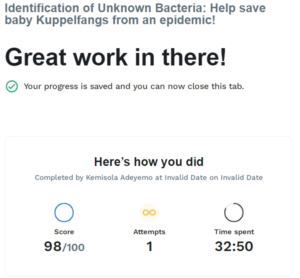COURSE
SCIE1046: Fundamentals Of Microbiology With Lab
1. About the Lab
Learning Objectives
- Explain the importance of correctly identifying pathogenic bacteria.
- Outline the principle of the main bacterial identification methods.
- Describe the use and limitations of bacterial morphology and differential staining techniques.
- Critically combine biochemical tests such as the catalase, oxidase and indole test. with differential staining and differential media to identify pathogenic bacteria.
Estimated Length: 40 to 45 minutes
MAKE THE CONNECTION
The background information in section 2 was adapted from the following Microbiology lecture course Tutorials:
1.2.5 Staining Methods
3.1.5 Biochemistry to Identify Microbes
4.1.4 Media Used for Microbial Growth
5.1.1 Classifications, Types, and Terminology of Disease
2. Background Information
The following background information will be helpful as you prepare for the simulation.
2a. Signs and Symptoms of Disease
An infection is the successful colonization of a host by a microorganism. Infections can cause disease, and this may cause the host to experience changes related to the infection. These changes are grouped into two categories: signs and symptoms.
The signs of a disease are objective and measurable, meaning that they can be observed by a clinician. For example, medical visits often begin with a health care professional taking vital signs to note any changes that may be signs of disease. Vital signs include body temperature, heart rate, breathing rate, and blood pressure. If someone has an unusually high body temperature (i.e., a fever), then that is a sign of disease. Other changes in vital signs can also signify the presence of an infection. Other examples of signs include measurements from blood analysis (e.g., white blood cell counts).
The symptoms of a disease are subjective. They are experienced by the individual who is sick and can be described but cannot be directly, objectively measured by a clinician even though the clinician can attempt to assess them (e.g., by asking a patient to rate their level of pain on a pain scale). Examples of symptoms include nausea, loss of appetite, and pain.
TERMS TO KNOW
These glossary terms are important to know and will help you during the Activity.
Infection
The successful colonization of a host by a microorganism.
Sign (of Disease)
A characteristic of a disease that is objective and measurable, meaning that it can be observed by a clinician.
Symptom (of Disease)
A characteristic of a disease that is subjective and cannot be directly, objectively measured by a clinician.
2b. Introduction to the Use of Biochemistry for Identification
It is often important to identify microbes for study. For example, it may be necessary to determine what pathogen is causing an illness to trace its spread or to choose a treatment approach.
Some microbes can be easily identified by their appearance, but others look similar or identical under the microscope. For example, it is often difficult to identify bacteria under the microscope based on shape and appearance. Staining may help, but generally is used to classify bacteria into groups (such as gram-positive or gram-negative) rather than for identification. In many cases, it takes multiple steps to identify a bacterium. These steps may include genotypic identification and biochemical characteristics.
Varied approaches are available that use biochemical characteristics to aid in identification. Some of these approaches involve determining whether a particular substance is present. For example, analysis of the contents of cytoplasmic granules can be useful in identifying certain bacteria. The presence or absence of the carbon- and energy-storage compound poly-β-hydroxybutyrate (PHB) and the presence or absence of fluorescent pigments can be helpful in identifying some species of the genus Pseudomonas.
Other approaches examine biochemical reactions used by different microbes. These include carbon utilization and other metabolic tests. These may be carried out individually, testing one reaction at a time, or using a system that allows panels of biochemical reactions to be carried out simultaneously and analyzed using software. Identifications can be performed manually or using automation.
2c. Staining Methods
You are encouraged to review the complete Microbiology lecture course Tutorial 1.2.5 Staining Methods for background on this topic before you begin the simulation.
2d. Media Used for Microbial Growth
You are encouraged to review the complete Microbiology lecture course Tutorial 4.1.4 Media Used for Microbial Growth for background on this topic before you begin the simulation.
3. Lab Manual
Lab Manual – Identification of Unknown Bacteria: Help save baby Kuppelfangs from an epidemic!
This Lab Manual gives a synopsis of the lab and the theory behind it. You’re encouraged to read or download the manual before launching the lab. This information will also be available during the simulation by selecting the “Theory” tab on the virtual LabPad.
4. Lab Report
This Activity has a Lab Report Touchstone assignment. Before launching the lab, review the Touchstone Assignment with rubric to see how you will be graded. While there, download and review the lab report file and fill it out as you complete the simulation.
IMPORTANT: You must submit the provided lab report file as your Touchstone. Any other submission file or format will be returned ungraded.
5. Launch Lab
You’re ready to begin! Review the helpful navigation tips below. Then click the Launch Lab button to start your lab. Be sure to answer all the questions in the simulation because they contribute to your score. Good luck, scientists!
- Exiting: To exit a lab simulation, press the ESC key on your keyboard. This key returns you to the objective screen for the simulation.
- Saving: You do not need to complete a simulation in one sitting. Labster saves your progress at predetermined checkpoints upon exit. To see your progress at any time, click on the mission tab of the LabPad.
- Restarting: You are allowed an unlimited number of restarts for a simulation to improve your quiz score. Sophia and Labster will always store your best score.
- Just Browsing: You can restart a simulation to have a look around without completing it. The program will still retain your previous (and best) score.

